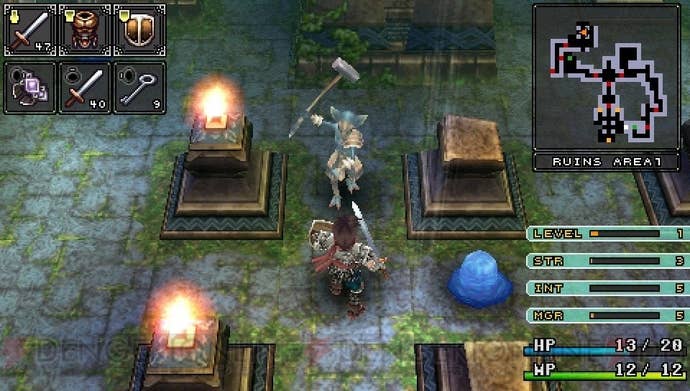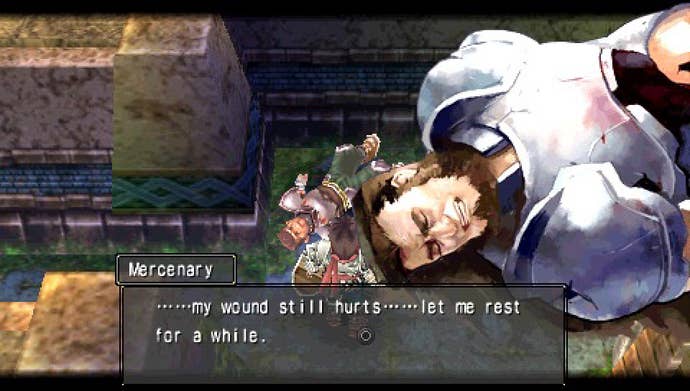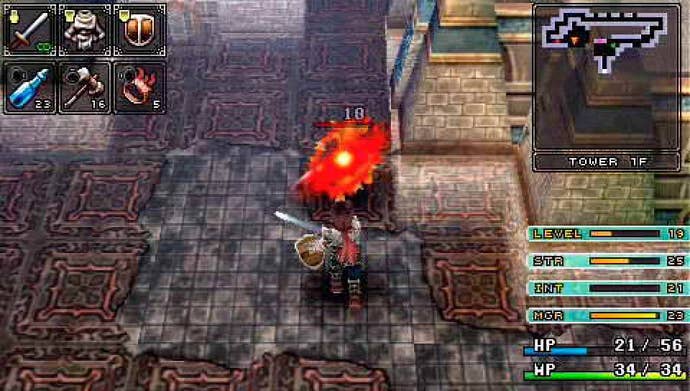Brandish: The Dark Revenant PSP/Vita Review: Niche, But Nice
Falcom's aging port of an ancient PC adventure won't be everyone's cup of mead, but it has its charms.
This article first appeared on USgamer, a partner publication of VG247. Some content, such as this article, has been migrated to VG247 for posterity after USgamer's closure - but it has not been edited or further vetted by the VG247 team.
Brandish: The Dark Revenant almost feels like a dare. As though publisher Xseed is defying you to like it.
Consider: While most people will likely play Brandish on PlayStation Vita, it's actually a PSP game. The idea of a new PSP release in 2015 alone seems sufficiently nutty, but it's an elderly PSP game at that — the original Japanese release happened way back in the dim and distant year of 2009, having languished in localization limbo for the past six years. Of course, at heart it's far older than that, a remake of a much older RPG simply called Brandish. If you know the game at all, you probably know it from its Super NES release back in 1995... but even 20 years ago, that Brandish was a remake of a PC game from 1991.
That's a lot of iterations for a game that would probably be pretty widely reviled if more people had ever actually played it. Falcom's no stranger to remakes, but the only game they've ported and reworked more than Brandish is the original Ys I & II — and, to put it lightly, Brandish doesn't command anywhere near the amount of tenacious fan affection the early Ys games do. On top of that, Brandish saw no less than three sequels through the years, too.
Why would Falcom reissue Brandish in so many forms over the years, and why would a tiny publisher like Xseed take what is presumably a significant risk on releasing an aging port of the game for an obsolete platform in 2015? To put it in Seinfeldean terms: "What's the deal with Brandish?"
If you've only played the Super NES version of Brandish, it's a fair question. That version of the game was literally dizzying, even nauseating. Its unique addition to the dungeon-crawler action RPG formula was a navigation mechanic whereby the protagonist (formerly called Varik, but renamed Ares in the remake) remained fixed at the center of the screen and the world spun around him. When players rotated the hero to face a different direction, he would remain fixed in place while the entire labyrinth wrenched 90 degrees around him. At the best of times, it was painfully disorienting. At the worst, it rendered the game effectively intolerable.
This facet of the game hasn't changed with the PSP remake, but The Dark Revenant makes a modest tweak to the design of the adventure that makes it infinitely more playable: Rather than jumping instantly to a new direction with each press of the shoulder buttons, the dungeon instead rotates quickly but smoothly through 90 degrees of motion. This has the side effect of slowing the action slightly to accommodate the fluid world motion — old-school Brandish was as fast-paced as it was senses-defying — but that's a small price to pay for an infinitely more player-friendly design.
You get a better sense of what the original game designers were aiming for with Brandish through this remake. Falcom was basically anticipating the future, prepping for the design conventions of 3D graphics. Modern action RPGs work much the same way as Brandish in concept — take Zelda, for instance. Since Ocarina of Time took the series into the third dimension, Link always faces forward, too, with his back to the player and the world revolving around him. Brandish was working toward that, but its high camera angle, snap-to-point rotation, and bitmap graphics made it all somewhat counterintuitive. Now that the future has caught up to what Falcom was trying to do, Brandish seems less baffling and more, well, quaint; The Dark Revenant recontextualizes the adventure as a 3D dungeon crawler locked into a 2D view.
With its new polygonal outlook, Brandish becomes a solid example of the genre. A bit dated, perhaps, but engrossing nevertheless. It taps into the elements that make the best dungeon RPGs so addictive. For example, it's not Etrian Odyssey, but as you venture forth into the labyrinth you can mark the auto-map with specific points of interest worth returning to. It's not a roguelike, but it conveys the same sensation of isolation, scarcity, and fragility as that style of game. Brandish touches on a lot of things I enjoy about role-playing games while presenting its own highly idiosyncratic experience.
Of course, I also realize it's not a game for everyone. Even in its reworked form, Brandish remains a methodical and often repetitive game. In fact, it goes out of its way to reward you for persistence and determination: At the end of each floor, you'll find a small stone monument that yields a reward if shattered once you've scoured 100% of that level's map. At first, this seems only moderately challenging — you'll occasionally need to break down fragile walls with a sledgehammer or find hidden keys to access certain rooms — but the further you advance into the dungeon the more complicated the task of full completion becomes.

Likewise, combat is similarly methodical, with a fairly simple rhythm. Ares wields both swords and spells, automatically blocking attacks from any enemy directly in the space in front of him. Initially, battle simply consists of patiently standing in a defensive posture to auto-block and counter, but eventually you'll meet foes that attack from a distance and whose projectiles have to be blocked manually, as well as creatures whose attacks can bypass Ares' shield. At the same time, the congested corridors of the labyrinth start to open out into wide open spaces in which enemies can attack you from multiple directions, and in which cautious maneuvering becomes the order of the day.
Bosses come few and far between, but the further you venture in the dungeon the more surprising the tactics they employ. These encounters demand a bit of twitch reflex skill, which helps break up the overall sameness of the dungeons — though admittedly the repetition in Brandish is somewhat front-loaded. The generally monotonous Ruins area in which you begin the adventure is easily the largest section of the game, and as you make progress you'll come across areas that change things up... including the decidedly harsh Dark Zone, where you have no visual range and enemies wield incredible power.

Even at its most unforgiving, Brandish is never completely abusive or unreasonable. This remake softens some of the cruel edges of the original game, with small improvements like a more useful mini-map that makes it far easier to orient yourself as you explore. It reinforces the save-anywhere design with an item called "Retry Bread" that allows you to instantly respawn if you die — and you'll definitely die, from being surprised by a new enemy type, or by plummeting into a gauntlet of traps, or letting yourself be flung into a pincer attack when you step on a secret warp tile, or any number of other, sudden tragedies.
It also includes a sort of remixed post-game bonus mode in which you play through a series of levels as Ares' would-be nemesis, the sorceress Dela. In the main game, your encounters with Dela invariably end with her stumbling into some sort of trap while cockily taunting the hero; fittingly, her solo journey is vastly more difficult than Ares', with deadlier labyrinth arrangements and more powerful monsters to deal with. (No wonder she seems so annoyed every time you see her.)

Even with The Dark Revenant's newfound tweaks and perks, make no mistake: Brandish will appeal to only a small subset of RPG enthusiasts. It lacks the zip and sizzle to hit a wide audience, and core design elements (like dense labyrinths of trap floors) require a certain intensity of conviction — the kind of player willing to take a vast dungeon step-by-step, dropping steels balls on each and every tile of floor to check for traps, or willing to retrace their steps to go hunting for that last three percent of the current floor they somehow overlooked.
Fortunately, the sort of person likely to be drawn in by Brandish is also the sort of person who won't really care that this isn't a native Vita title. They're the sort of player who will spend time dabbling in games rendered in ASCII text of their own free will, possibly the kind of person who soldiered through the unfriendly older version of Brandish back in the 16-bit era. By those standards, The Dark Revenant's stiff-but-effective polygons will seem a glorious luxury.
VisualsPretty rudimentary, but the fixed angle and smart color palettes go a long way toward covering up its chunky simplicity.
SoundGreat sound effects and absolutely divine music — and you get to choose whether you prefer the classic FM synth sound style or a lush arrangement.
InterfaceBrandish's control scheme remains pretty kooky, but it makes more sense to rotate the world when it's presented like this.
Lasting AppealA huge RPG, completing the game and its bonus mode is a good 50-60 hour commitment. Those hours can be fairly repetitive, but they're satisfying nevertheless.
ConclusionBrandish may be among the most niche of RPGs, but it doesn't suffer any illusions to the contrary. It's comfortable in its own skin and happy to commit to its own rules and limitations. Most people will find themselves indifferent to its focused, idiosyncratic design — but those who get it will love it.


